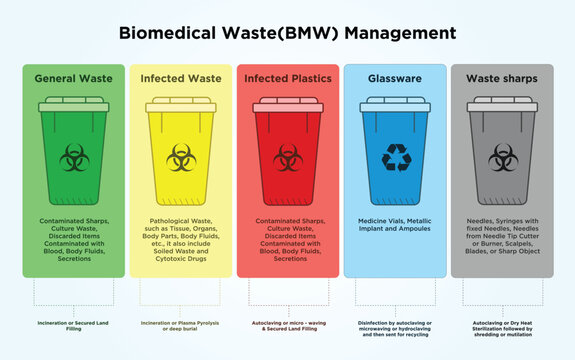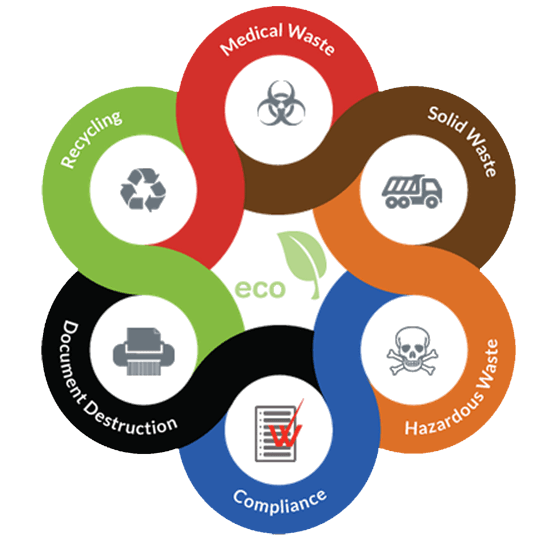Strategic Medical Waste Disposal Solutions: Encouraging Security and Sustainability
Wiki Article
Effective Methods of Medical Waste Disposal
Reliable techniques of clinical garbage disposal are vital in maintaining public wellness and environmental security. Medical waste, consisting of sharps, pathological waste, and pharmaceutical waste, have to be taken care of and thrown away appropriately to avoid the spread of infections and secure the environment. This needs adherence to rigorous regulations and the implementation of specialist waste monitoring practices.Correct partition of clinical waste, secure and safe storage space, effective treatment and disinfection methods, and environmentally-friendly disposal alternatives are key parts of an efficient medical garbage disposal system. Professional waste administration solutions play an important duty in making sure compliance with regulations and minimizing the risks related to improper disposal. By utilizing these methods, healthcare facilities can add to a much safer and cleaner setting while guarding the well-being of the neighborhood.
Proper Segregation of Medical Waste
Proper partition of medical waste is important for guaranteeing the safe and effective disposal of these potentially unsafe products. Medical waste describes any type of waste created throughout medical care tasks, such as hospitals, facilities, laboratories, and research centers. It consists of a vast array of products, such as utilized needles, syringes, contaminated dressings, ran out or extra medicines, and biological materials.By setting apart clinical waste, healthcare facilities can decrease the risk of infections, injuries, and environmental contamination. The procedure includes categorizing waste right into different kinds, such as sharps, infectious waste, pharmaceutical waste, and non-hazardous waste. Each kind requires specific handling, product packaging, and disposal techniques to avoid exposure to medical care workers, waste management employees, and the general public.
To ensure correct partition, healthcare facilities ought to establish clear guidelines and give sufficient training to employee. This consists of enlightening workers on the different waste groups, appropriate packaging techniques, and the use of appropriate containers - WasteX Medical Waste Disposal. In addition, clear signs and color-coding systems can be implemented to promote the recognition and segregation of various waste kinds
Safe and Secure Storage Space of Medical Waste
Safe and safe storage space of medical waste is critical for maintaining the integrity and control of potentially hazardous products. Proper storage not only protects health care workers and the basic public from direct exposure to hazardous substances however also prevents ecological contamination.To ensure safe storage space, medical facilities must adhere to particular standards. Waste needs to be saved in watertight and puncture-resistant containers that are classified properly - medical waste disposal.
Correct partition of medical waste is likewise necessary for safe storage space. Different kinds of waste, such as sharps, contagious materials, and pharmaceutical waste, must be separated to avoid cross-contamination. This segregation can be achieved via making use of color-coded bins or containers.
Regular monitoring and inspection of the storage space area are vital to determine any possible dangers or violations. This includes monitoring for indications of damage or deterioration in the containers, making certain appropriate ventilation, and monitoring temperature level and moisture levels.
Reliable Therapy and Disinfection Approaches

One generally used treatment technique is autoclaving, which entails subjecting the waste to high-pressure vapor at temperature levels over 121 degrees Celsius. This process efficiently eliminates microbes and destroys contagious representatives, providing the waste safe for further disposal. One more technique is incineration, which includes melting the waste at high temperatures. Incineration not only eliminates microbes yet additionally lowers the waste quantity with combustion.
Chemical disinfection is another effective approach for treating medical waste. This method entails making use of disinfectants such as chlorine substances, phenolic compounds, or hydrogen peroxide to eliminate or inactivate microorganisms (WasteX Medical Waste Disposal). Chemical disinfection is typically used for fluid waste, such as lab samples or physical fluids
In recent years, alternative therapy techniques such as microwave sanitation, irradiation, and biological treatment have also gotten focus. These methods use advantages such as reduced ecological influence and energy usage compared to standard methods.
Environmentally-friendly Disposal Options
In the world of medical waste disposal, considering environmentally-friendly choices is essential. Healthcare facilities produce a significant amount of waste, consisting of infectious materials, drugs, and chemicals, which can position serious dangers to human health and the environment otherwise taken care of correctly. There are a number of environmentally-friendly disposal options readily available that can help reduce these dangers.
Reusing medical waste involves setting apart and processing certain materials for reuse or repurposing. Furthermore, some medical care centers have executed recycling programs for certain clinical tools or equipment, further reducing waste generation.
This approach includes converting medical waste into power through procedures like incineration or anaerobic digestion. Anaerobic digestion, on the various other hand, breaks down organic waste in the lack of oxygen, producing biogas that can be made use of for power or warmth generation.

Advantages of Specialist Waste Monitoring Solutions
One considerable benefit of specialist waste monitoring services is the boosted efficiency in taking care of and disposing of medical waste. By making use of specialist waste administration solutions, healthcare centers can ensure that all medical waste is dealt with and disposed of correctly, reducing the danger of contamination and the spread of illness.Specialist waste administration solutions employ trained and skilled employees that are knowledgeable concerning the guidelines and standards for clinical garbage disposal. They have access to customized equipment and devices that enable them to manage various sorts of medical waste safely and efficiently. These solutions also have reputable treatments and procedures in position to guarantee that waste is set apart, packaged, delivered, and disposed of in conformity with local, state, and federal policies.
Additionally, expert waste administration solutions can provide medical care facilities with thorough waste administration services. They can offer solutions such as waste collection, transport, therapy, and disposal, customized to the specific demands and needs of the facility. This removes the concern of handling waste inside, enabling healthcare team to concentrate on providing high quality patient treatment.
Conclusion
In verdict, reliable methods of clinical waste disposal include correct partition, risk-free storage space, treatment and disinfection, and environmentally-friendly disposal options. These methods ensure the secure handling and administration of clinical waste, preventing the spread of infections and safeguarding the setting.Clinical waste, including sharps, these details pathological waste, and pharmaceutical waste, need to be managed and disposed of appropriately to protect against the spread of infections and safeguard the atmosphere.Proper partition of medical waste, protected and risk-free storage space, efficient treatment and sanitation methods, and environmentally-friendly disposal alternatives are crucial components of an effective medical waste disposal system. The procedure involves classifying waste right into different kinds, such as sharps, infectious waste, pharmaceutical waste, and non-hazardous waste. By using specialist waste administration services, healthcare centers can make certain that all clinical waste is managed and disposed of effectively, decreasing the risk of contamination and the spread of conditions.
Specialist waste monitoring services use seasoned and trained workers that are experienced regarding the regulations and standards for clinical waste disposal.
Report this wiki page